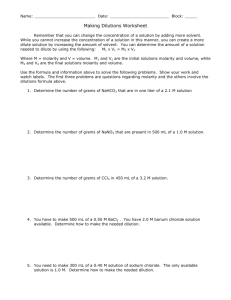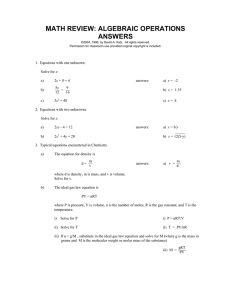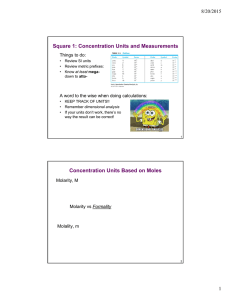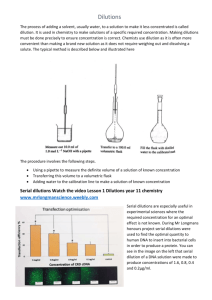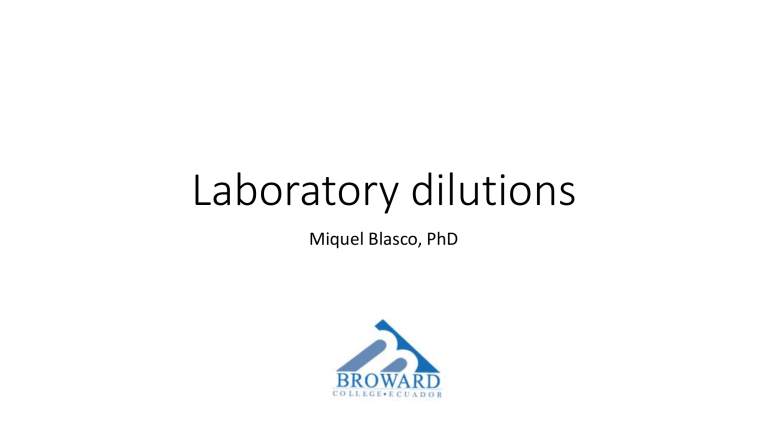
Laboratory dilutions
Miquel Blasco, PhD
A solution is a homogenous mixture of 2 or more
substances
The solute is(are) the substance(s) present in the
smaller amount(s)
The solvent is the substance present in the larger
amount
Solution
Solvent
Solute
Soft drink (l)
H2O
Sugar, CO2
Air (g)
N2
O2, Ar, CH4
Soft Solder (s)
Pb
Sn
4.1
Solutions
Solvent
solute
When the solvent is water the solution is said to be aqueous
General Properties of Aqueous Solutions
A solution is a homogenous mixture of two or more substances.
The substance present in the largest amount (moles) is referred to as the solvent.
The other substances present are called the solutes.
A substance that dissolves in a particular solvent is said to be soluble in that solvent.
Dilutions for the Clinical Laboratory
• Dilution = making weaker solutions from stronger ones
Example: Making orange juice from frozen concentrate. You mix one
can of frozen orange juice with three (3) cans of water.
Dilutions for the Clinical Laboratory (cont’d)
• Dilutions are expressed as the volume of the solution being diluted
per the total final volume of the dilution
•
In the orange juice example on the previous slide, the dilution would be
expressed as 1/4, for one can of O.J. to a TOTAL of four cans of diluted O.J.
• When saying the dilution, you would say, in the O.J. example: “one in four”.
Dilutions for the Clinical Laboratory (cont’d)
• Another example:
If you dilute 1 ml of serum with 9 ml of saline, the dilution would be
written 1/10 or said “one in ten”:
because you express the volume of the solution being diluted (1 ml of
serum) per the TOTAL final volume of the dilution (10 ml total).
Dilutions for the Clinical Laboratory (cont’d)
• Another example:
One (1) part of concentrated acid is diluted with 100 parts of water.
The total solution volume is 101 parts (1 part acid + 100 parts water).
The dilution is written as 1/101 or said “one in one hundred and one”.
Dilutions for the Clinical Laboratory (cont’d)
• Notice that dilutions do NOT have units (cans, ml, or parts) but are
expressed as one number to another number
Example: 1/10 or “one in ten”
Dilutions for the Clinical Laboratory (cont’d)
• Dilutions are always expressed with the original substance diluted as
one (1).
• If more than one part of original substance is initially used, it is
necessary to convert the original substance part to one (1) when the
dilution is expressed.
Dilutions for the Clinical Laboratory (cont’d)
Example:
Two (2) parts of dye are diluted with eight (8) parts of diluent (the term often used for the
diluting solution).
The total solution volume is 10 parts (2 parts dye + 8 parts diluent).
The dilution is initially expressed as 2/10, but the original substance must be expressed as one
(1).
To get the original volume to one (1), use a ratio and proportion equation, remembering that
dilutions are stated in terms of 1 to something:
______2 parts dye
= ___1.0___
10 parts total volume
x
2x
=
10
x
=
5
The dilution is expressed as 1/5.
Dilutions for the Clinical Laboratory (cont’d)
The dilution does not always end up in whole numbers.
Example:
Two parts (2) parts of whole blood are diluted with five (5) parts of saline. The total solution
volume is seven (7) parts (2 parts of whole blood + 5 parts saline). The dilution would be 2/7,
or, more correctly, 1/3.5. Again, this is calculated by using the ratio and proportion equation,
remembering that dilutions are stated in terms of 1 to something:
__2 parts blood_____
= ___1.0___
7 parts total volume
x
2x
=
7
x
=
3.5
The dilution is expressed as 1/3.5
Dilutions for the Clinical Laboratory (cont’d)
• Dilution Factor – used to correct for having used a diluted sample in a
lab test rather than the undiluted sample.
• The result (answer) using the diluted sample must be multiplied by
the RECIPROCAL of the dilution made.
• The RECIPROCAL of a 1/5 dilution is 5.
Dilutions for the Clinical Laboratory (cont’d)
• Correction for using a diluted sample
Example: A technician performed a laboratory analysis of patient’s serum
for a serum glucose (blood sugar) determination.
The patient’s serum glucose was too high to read on the glucose
instrument.
The technician diluted the patient’s serum 1/2 and reran the diluted
specimen, obtaining a result of 210 g/dl.
To correct for the dilution, it is necessary to multiply the result by the
dilution factor (in this case x 2). The final result is 210 g/dl x 2 = 420 g/dl.
Dilutions for the Clinical Laboratory (cont’d)
• Sometimes it is necessary to make a dilution of an existing solution to
make it weaker.
Example:
A 100 mg/dl solution of substrate is needed for a laboratory
procedure.
All that is available is a 500 mg/dl solution of substrate.
A dilution of the stronger solution of substrate is needed.
Dilutions for the Clinical Laboratory (cont’d)
• To make a weaker solution from a stronger one, use this formula:
V1 x C1 = V2 x C2
Example: To make 100 ml of the 100 mg/dl solution from the 500 mg/dl solution needed in
the previous example:
Dilutions for the Clinical Laboratory (cont’d)
• To make a weaker solution from a stronger one, use this formula:
V1 x C1 = V2 x C2
Example: To make 100 ml of the 100 mg/dl solution from the 500 mg/dl solution needed in
the previous example:
V1 = 100 ml
V2 = V2 (unknown)
C1 = 100 mg/dl
C2 = 500 mg/dl
100 ml x 100 mg/dl = V2 x 500 mg/dl
V2 = 20 ml
Dilute 20 ml of 500 mg/dl solution up to 100 ml with water to obtain 100 ml of 100 mg/dl
substrate solution
Serial Dilutions
• Dilutions can be made singly (as shown previously) or in series, in
which case the original dilution is diluted further.
• A general rule for calculating the dilution of solutions obtained by
diluting in a series is to MULTIPLY the original dilution by subsequent
dilutions.
Serial Dilutions (cont’d)
• Example of a serial dilution:
What is a mole (or mol)?
• "that equal number" of atoms arbitrarily chosen.
• the number of atoms in the atomic weight in g of any element.
• the number of atoms in 16 g of oxygen, in 4 grams of He, in 32 g of sulfur,
etc.
• the number of molecules in the molecular weight, in grams, of any
compound.
• the number of molecules in 18 g of water, in 40 g of lithium carbide.
• Much later, a mole, that equal number, was found to be 6.022 x
1023(representative particles).
Examples
• 1 mole (or abbr. mol) = 12.011 g of Carbon
• 1 mol of Carbon = 6.02 x 1023 atoms of C
• 1 mol of H2O = 6.02 x 1023 molecules of water
• 1 mol of NaCl = 6.02 x 1023 units of NaCl
Figure 8.1: All these samples of pure elements contain the
same number (a mole) of atoms: 6.022 x 1023 atoms.
Copyright © Houghton Mifflin Company.All rights reserved.
8–5
Moles in mass
• 1 mole can equal the atomic weight of an element.
• 1mol of C = 12.011g of C
• 1 mole can equal the atomic weight of a compound
• 1mol of CO = 12.011g of C + 15.99 g of O
= 28.0 g of CO
Group Whiteboards
• How many grams are in 1 mol of
• Nitrogen?
• Dinitrogen monoxide?
**How many mols are in 100g sample of N2O?
Warm Up #8
• How many grams of Cu are in 1.20 mol of Cu?
• How many moles are in 70g of Cl?
Mole Conversions
• Mass to mole or vice versa:
• How many moles are in 24 g of Carbon?
Mole Conversions
• Mass to mole or vice versa:
• How many moles are in 24 g of Carbon?
• Look at the boomerang:
• Start with the given: 24 g (mass) of C
• What do you want in the end? Moles of C
• Use the conversion factor given:
• 1 mole
Atomic mass
24 g of C x 1 mol of C = 2.0 mol of Carbon
12.011 g of C
White boards
• How many molecules of oxygen gas are in 3.0 mols of Oxygen gas?
• How many mols of Oxygen gas are in
4.67 x 1024 molecules of Oxygen gas?
Concentration of Solutions
Molarity (M), or molar concentration, is defined as the number of
moles of solute per liter of solution.
molarity =
moles solute
liters solution
Other common
rearrangements:
L=
mol
M
mol = M L
Example 1: Find molarity given moles and
liters
• Determine the molarity when 3.0 moles of sucrose are dissolved to
make 2.0 liters of solution.
Example 2: Find moles given molarity and
liters
• Determine the number of moles of salt dissolved in 5.0 liters of a
0.50M solution of salt water
Example 3: Find molarity given grams (instead
of moles) and liters of solution
• Determine the molarity when 117g of NaCl are dissolved to make
0.500 liters of solution.
Example 4: Find molarity given grams (instead of
moles) and milliliters of solution (instead of liters)
• Determine the molarity when 55.5g of CaCl2 are dissolved to make
250.mL of solution.
Practice problems
• You will be broken into pairs. One student works on the 1st questions
while the second student works on the 2nd question. (3 min)
• Then each student will be given a minute to explain to the other
student how the problem was solved. (2 min)
Practice Multiple Choice Questions
1. What is the molarity of a
solution of NaOH if 2 liters of the
solution contains 4 moles of
NaOH?
2. How many total moles of KNO3
must be dissolved in water to
make 1.5 liters of a 2.0 M
solution?
(1) 0.5 M (2) 8 M
(3) 2 M
(4) 80 M
(1) 0.50 mol (2) 2.0 mol
(3) 3.0 mol (4) 1.3 mol
Practice Multiple Choice Problems
3. What is the molarity of a
solution containing 20 grams of
NaOH in 500 milliliters of
solution? (molar mass NaOH =
40g/mol)
4. What is the molarity of 1.5 liters
of an aqueous solution that
contains 52 grams of lithium
fluoride, LiF, (gram-formula mass
=26 grams/mole)?
(1) 1 M
(3) 0.04 M
(1) 1.3 M (2) 3.0 M
(3) 2.0 M (4) 0.75 M
(2) 2 M
(4) 0.5 M
Practice short response
5. In laboratory activity, 0.500
mole of NaOH (s) is dissolved in
distilled water to form 400. mL of
NaOH (aq).
• Calculate the molarity of
NaOH(aq).
6. A 2.0-liter aqueous solution
contains a total of 3.0 moles of
dissolved NH4Cl at 25°C and
standard pressure.
Determine the molarity of the
solution.

